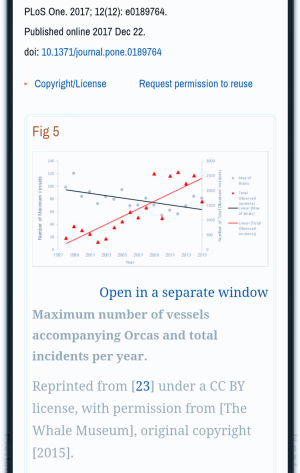searun
Well-Known Member
All the public concern over SRKW sure makes for great opportunities for marine mammal researchers to feather their nests - you may have noted in yesterday's budget that there is a new $151 million fund for whales...no new investment for salmon recovery. Hmmm.
Inbreeding sure could be a problem, however there are also other significant factors and poorly constructed management measures aimed at protecting SRKW that are hindering recovery and needlessly decimating coastal communities that rely upon the recreational fishery for their social, cultural and economic well-being!
All of this begs the question, why are NRKW populations increasing whereas their SRKW cousins are low and stable? Could all the fuss over caloric deficits for SRKW be more related to the prolific expansion of the whale watching industry - their business model is to get as close to foraging whales as possible - and we all know that science is pointing to physical and acoustic disturbances as an impact to forage activity/success.
I would also go out on a limb (because the research hasn't yet investigated this issue), that SRKW diet may also be a contributing factor. Many of the Chinook stocks SRKW feed upon pass through toxic waters - could it be that by consuming Salmon with high levels of toxins in their livers could be aggregating those toxins in juvenile SRKW passed along by their mother's milk???
Then there's the poorly constructed management responses to protect SRKW.
The regulatory or protection response is vastly different between Canada and US. US have implemented strict avoidance bubbles, and are now in the process of expanding those from 400 yards to 1000 yards - no exceptions, no special permits for Whale Watchers. Whereas, in Canada we implemented a number of "sanctuaries" which are fixed static measures that afford no protection for whales when whales are not present.
We have a 400m avoidance zone concept - but it largely will fail because there is limited enforcement and education support to shift vessel operator behaviors. AND worse, we give Whale Watchers a special permit so they can get closer than that recommended by the science - 200m vs 400m. Seems to me that Canada's approach is designed more to put out splashy maps that make it appear that we are protecting whales and appeasing the ENGO crowd who have a hate on for recreational fishing - to the point they outright mis-represent the facts.
Inbreeding sure could be a problem, however there are also other significant factors and poorly constructed management measures aimed at protecting SRKW that are hindering recovery and needlessly decimating coastal communities that rely upon the recreational fishery for their social, cultural and economic well-being!
All of this begs the question, why are NRKW populations increasing whereas their SRKW cousins are low and stable? Could all the fuss over caloric deficits for SRKW be more related to the prolific expansion of the whale watching industry - their business model is to get as close to foraging whales as possible - and we all know that science is pointing to physical and acoustic disturbances as an impact to forage activity/success.
I would also go out on a limb (because the research hasn't yet investigated this issue), that SRKW diet may also be a contributing factor. Many of the Chinook stocks SRKW feed upon pass through toxic waters - could it be that by consuming Salmon with high levels of toxins in their livers could be aggregating those toxins in juvenile SRKW passed along by their mother's milk???
Then there's the poorly constructed management responses to protect SRKW.
The regulatory or protection response is vastly different between Canada and US. US have implemented strict avoidance bubbles, and are now in the process of expanding those from 400 yards to 1000 yards - no exceptions, no special permits for Whale Watchers. Whereas, in Canada we implemented a number of "sanctuaries" which are fixed static measures that afford no protection for whales when whales are not present.
We have a 400m avoidance zone concept - but it largely will fail because there is limited enforcement and education support to shift vessel operator behaviors. AND worse, we give Whale Watchers a special permit so they can get closer than that recommended by the science - 200m vs 400m. Seems to me that Canada's approach is designed more to put out splashy maps that make it appear that we are protecting whales and appeasing the ENGO crowd who have a hate on for recreational fishing - to the point they outright mis-represent the facts.







